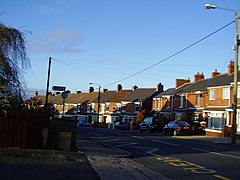Sacriston
| Sacriston | |
|---|---|
 Main road through Sacriston |
|
| Sacriston shown within County Durham | |
| Population | 4,999 2011 Census |
| OS grid reference | NZ240470 |
| Unitary authority | |
| Ceremonial county | |
| Region | |
| Country | England |
| Sovereign state | United Kingdom |
| Post town | DURHAM |
| Postcode district | DH7 |
| Dialling code | 0191 |
| Police | Durham |
| Fire | County Durham and Darlington |
| Ambulance | North East |
| EU Parliament | North East England |
| UK Parliament | |
Sacriston is a village and civil parish in County Durham, England, situated 3 miles (4.8 km) north of the city of Durham.
Although the area has been populated since the Bronze Age, the first recorded settlement dated back to the 13th century to Sacristan's Heugh. According to old maps it was once known as "Segerston Heugh" and is now known to local people as "Segga". This farm and manor house was once the residence of the Sacristan, a monk who held the Office of the Sacristan of the monastery at Durham Cathedral. The Sacristan was responsible for providing everything necessary for the services of the Cathedral: bread and wine, the vestments etc. He was also responsible for repairs to Durham Cathedral. The funds for carrying out the official duties were generated from the estate of Sacristan's Heugh which was finally demolished shortly after World War II.
Sacriston Colliery shaft was sunk in 1838 and by the 1890s the pit employed 600 men, producing 1,000 tons of coal a day.
On Monday 16 November 1903, water flooded into the 3rd West district of the 'Busty' Seam. The inrush killed two miners: John Whittaker (25) and Thomas McCormick (52). McCormick family tradition (source Harry McCormick) is that Thomas McCormick's son Gregory had to be restrained from rushing into the flood. When the workings were pumped out another man, Robert Richardson was found on Friday standing on his coal tub having been stranded in the dark, surrounded by dirty flood water for 92 hours.
"The inquest was opened by Mr. Coroner Graham on the 20th November and adjourned till the 9th December when evidence was taken, and the jury returned a verdict that the two men were accidentally drowned, and that, owing to the peculiar circumstances, no blame attached to the management."
The Royal Humane Society awarded their silver medal to six mine officials. The enquiry lasted just five hours. See the Durham County Advertiser news report.
There is a photograph of a contemporary souvenir at https://www.flickr.com/photos/greg_mccormick/8818617256/
Durham Mining Museum has further information, for instance at http://www.dmm.org.uk/individ1/i11353.htm
Miners themselves have not all been convinced that the management was innocent or that the medals were appropriate. There have been suggestions that cover-ups were commonplace. Decades later workers stumbled on the skeleton of one of the pit ponies that died during the accident and a full tub of coal that still bore a miners token (miners were on piece work). The miner then received his back pay.
...
Wikipedia

